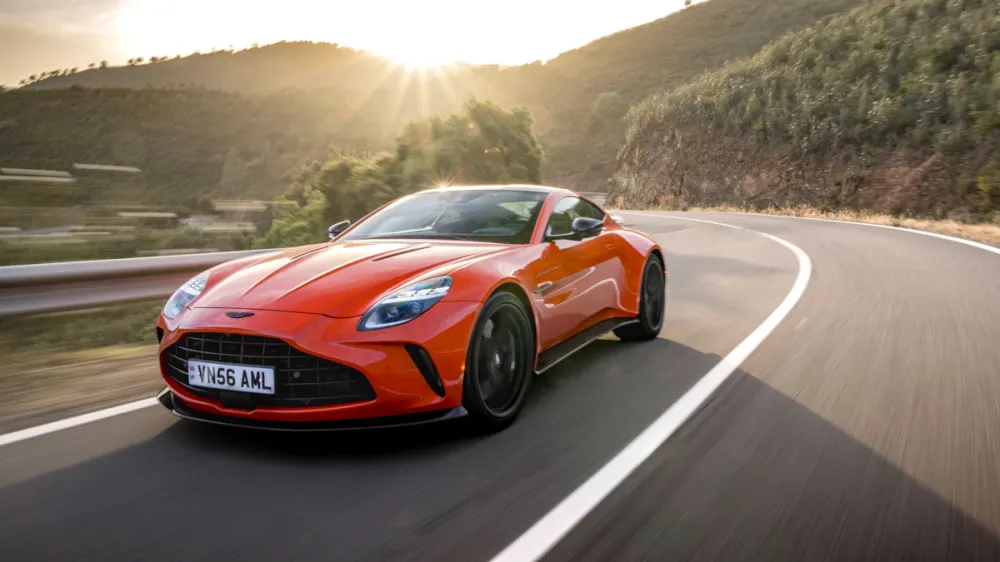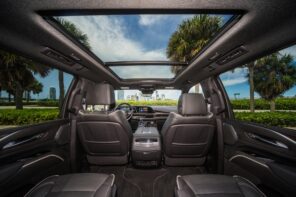The new Aston Martin Vantage marks a significant step in the ambitious plan of the marque’s executive chairman, Lawrence Stroll, to reinvent the storied British sports-car manufacturer. Stroll aims to elevate Aston Martin further upmarket, distinguishing it from competitors such as Porsche and Mercedes-AMG.
The DB12 features a mildly restyled exterior and a significantly more luxurious interior showcasing the automaker’s in-house-developed infotainment system. The DB12 also received more power and numerous chassis upgrades compared to its predecessors. Following the same formula, the 2025 Vantage boasts 30 percent more power and 15 percent more torque than the outgoing model. Aston Martin claims it can sprint from zero to 60 mph in 3.4 seconds and reach a top speed of 202 mph.

The Vantage’s exterior exudes coiled muscle and menace, presenting a hungry beast ready to pounce. The front and rear fenders are pumped out 1.2 inches to cover a wider track, accented by 21-inch forged alloy wheels wrapped in new Michelin Pilot Sport 5 S tires developed specifically for the car. A longer hood runs down to a grille opening that’s 38 percent larger to improve cooling, flanked by vertical vents that create air curtains around the front wheels to enhance aerodynamic efficiency. The vents pull the front corners of the car outward, further emphasizing its width. At the rear, a new diffuser with bazooka-like dual exhausts on either side works with the rear spoiler to produce a maximum of 158 pounds of downforce on the rear axle at speed.
The redesigned interior is a significant improvement over the outgoing model. The dash now features a horizontal vent graphic that emphasizes the cabin’s width, along with a new 10.25-inch digital instrument panel housed in a dramatically styled binnacle. The gearshift paddles are attached to a new three-spoke sports steering wheel with touch capacitive switches.

At the center of the dash is a 10.25-inch touchscreen that is fast-reacting and intuitive. Below it is a new center console that, like in the DB12, hosts physical controls for gear selection, temperature adjustment, fan speed, and audio volume, as well as the ignition start button surrounded by the rotary drive-mode selector.
Under the hood is a reworked version of the 4.0-liter V-8 originally developed by Mercedes-AMG, first used by Aston in the eight-cylinder version of the 2018 DB11. A deal brokered in 2020, when former AMG boss Tobias Moers was Aston Martin’s CEO, grants the British automaker more freedom to determine the engine’s performance level. This versatile and highly tunable engine now powers the DB12 and the DBX707 SUV and will also be the muscle for the mid-engine Aston Martin Valhalla supercar set to debut before the end of this year.

In the 2025 Vantage tune, the engine produces 656 hp from 6,000 rpm to 6,500 rpm and 590 ft-lbs of torque from 2,750 rpm to 6,000 rpm, courtesy of new cylinder heads, camshafts, larger turbochargers, and a new exhaust system. The power and torque increases compared to the outgoing model’s V-8 engine take effect from 2,000 rpm, contributing to a 40 percent increase in throttle response during performance driving. The larger front grille allows 50 percent more air to pass through additional power-train coolers, with hot air extracted via strategically placed vents on the hood.
The engine drives the rear wheels through a revised ZF eight-speed automatic transaxle transmission, recalibrated to deliver faster, smoother shifts, and handle the engine’s higher torque output. The gear ratios remain the same as those of the outgoing Vantage, but the e-diff’s final drive ratio has been shortened to deliver faster acceleration.

Five different drive modes are now available, with the default start mode being Sport. Twisting the rotary controller to the right selects Sport+, enhancing the power train’s response and stiffening the suspension. Drivers can mix and match power train and suspension settings in Individual mode, and a new Wet mode calms the power train and increases the stability control’s intervention threshold for easier driving on wet or snowy roads. Track mode allows drivers to switch off stability control and choose from nine different levels of traction control.
The suspension follows the same multi-link layout front and rear as the previous Vantage, with adjustments to improve steering stiffness by 35 percent and the body’s overall torsional rigidity by seven percent. The new Bilstein DTX adaptive shocks provide five times the tuning range of the previous model’s shocks, working with new springs and stabilizer bars to reduce understeer by 12 percent and improve ride and body control.

The new Vantage’s enhanced precision is evident in the first mile, with improved steering, braking, body control, and power-train response. It’s a sharper, more focused car than the outgoing Vantage, yet it feels more refined, with a better ride at low speeds. But the new Aston really comes alive on a quiet, winding two-lane road. It’s quick and responsive, even in the default Sport mode and with the transmission left to its own devices. Activating manual-shift mode instantly increases the pace, allowing you to fully access the engine’s broad operating window, perfect for maintaining momentum on an unfamiliar road.
While selecting Sport+ mode stiffens the Vantage’s responses, the suspension setting was too stiff for some of the rougher, hilly Spanish roads encountered during the test drive, causing the rear tires to occasionally lift. However, selecting Individual mode and dialing the suspension back to Sport while keeping the power train in Sport+ settled the car.

On a smooth and empty road, the Aston shone in Sport+ mode, with the V-8 bellowing as it powered the Vantage through corners and along straights. The optional carbon-ceramic brakes, which reduce unsprung weight by 60 pounds, provided confident braking, while the front axle responded immediately to steering commands.
On the fast and twisting Circuito Monteblanco racetrack near Seville, we explored the Vantage’s dynamic capabilities, playing with the car in Track mode with stability control off and adjusting the traction control. The abundant feedback from the chassis allowed for optimal balance through corners with brake and throttle inputs.

The new Aston Martin Vantage is very impressive but not perfect. The track sessions highlighted the need for a dual-clutch transmission to fully exploit the chassis’s precision and the power train’s punch. The ZF eight-speed auto is smooth and robust for most driving but lacks quickness in manual mode. A shift light would also help to optimize gear changes, as the V-8 reaches 7,000 rpm with ease. The somewhat small graphics on the digital dash are hard to read, which doesn’t help.
The steering could benefit from lighter weighting to reduce artificial inertia and improve cornering response. A wider blending of throttle and brake input maps would prevent occasional power cuts when left-foot braking.
While the new Vantage competes closely with the Porsche 911, it offers a different experience. Priced starting at $191,000, just under the 911 Turbo, the Vantage may not match the Porsche’s 24/7 usability, but it offers a more engaging and visceral driving experience. The Vantage roars to life when driven hard, providing a connection that gives confidence to push both the car and driver to their limits.





